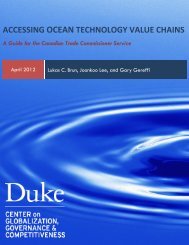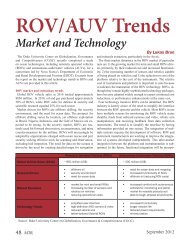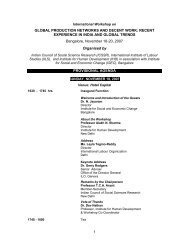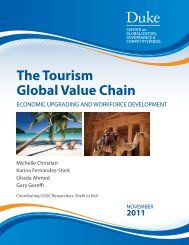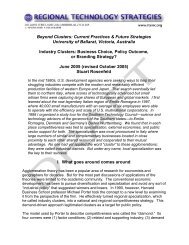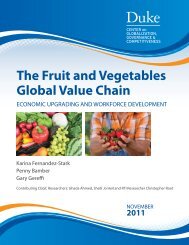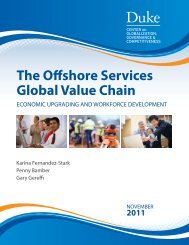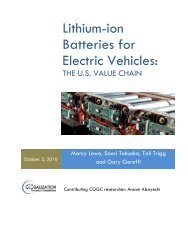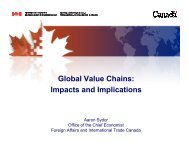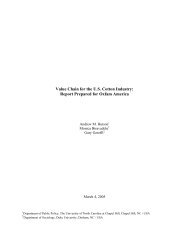Kenyan Apparel Beyond AGOA
Kenyan Apparel Beyond AGOA
Kenyan Apparel Beyond AGOA
You also want an ePaper? Increase the reach of your titles
YUMPU automatically turns print PDFs into web optimized ePapers that Google loves.
<strong>Kenyan</strong> <strong>Apparel</strong> <strong>Beyond</strong><br />
<strong>AGOA</strong><br />
Tina Mangieri<br />
UNC Chapel Hill
Upan Wasana EPZ, Ruaraka, Nairobi Nairobi<br />
• <strong>Kenyan</strong> textiles &<br />
apparel overview<br />
•<strong>AGOA</strong><br />
• mitumba<br />
• refashioning apparel<br />
in Africa<br />
• future possibilities
<strong>Kenyan</strong> <strong>Apparel</strong> in Brief:<br />
• colonial-era production<br />
& consumption<br />
• post-independence<br />
strategies:<br />
–ISI<br />
–SAPs<br />
–EPZs/MUB<br />
kanzu & khanga, Mombasa
women’s trousers, Nairobi EPZ<br />
<strong>AGOA</strong>
sewing button-holes, Nairobi EPZ<br />
hourly line quotas, Nairobi EPZ<br />
<strong>AGOA</strong><br />
• US legislation - 2000<br />
• Duty-free access to US for 38<br />
African countries<br />
• Kenya is second-leading exporter<br />
under <strong>AGOA</strong> (after Lesotho)<br />
• <strong>Apparel</strong> - leading export for Kenya<br />
• Extended to 2015 in 2003<br />
• Post-MFA effect on EPZ firms and<br />
employment:<br />
12 factory closures - 22 remain open<br />
loss of approx. 20,000 jobs<br />
38,600-39,800 current employees<br />
• Barring an extension,<br />
3rd country fabric provision expires<br />
September 2007
EPZ factory floor - Ruaraka, Nairobi
• September 2006 -<br />
US Congress indefinitely<br />
postponed legislation revising<br />
<strong>AGOA</strong> - after intensive<br />
lobbying by US textile groups -<br />
extending current duty-free<br />
access provisions until 31<br />
September 2008.<br />
• A new rule of origin was then to<br />
have been applied from 1<br />
October 2008 allowing 50 per<br />
cent non-African content<br />
decreasing to 40 per cent by the<br />
end of 2015.<br />
<strong>AGOA</strong> - rules of origin<br />
Intertex twill (Hong Kong) - Nairobi EPZ
skirts, Kikomba market, Nairobi<br />
MITUMBA
Secondhand Clothing in Kenya<br />
Kenya is the 3rd largest importer of used clothing<br />
in sub-Saharan Africa (by weight), by per capita consumption, by estimated<br />
number of pieces, and by estimated workforce - after Tanzania and Ghana<br />
country Weight (Kg) Consumption<br />
per capita (kg)<br />
Estimated #<br />
of garments<br />
Estimated #<br />
of traders<br />
Tanzania 48,932,746 1.375 195,730,984 90,616**<br />
Ghana 41,270,997 2.064 165,083,988 76,428**<br />
Kenya 38,568,416 1.240 154,273,664 71,423**<br />
2003 data, UN Trade Statistics<br />
** UTGLWF estimates, 2003
Top 5 Exporters of<br />
Used Clothing to<br />
Kenya (by weight)*:<br />
1. UK<br />
2. Canada<br />
3. US<br />
4. Italy<br />
5. Germany<br />
Kikomba mitumba market, Nairobi * 2005, Kenya Revenue Services
Mitumba seller, Kikomba, Nairobi<br />
Estimated monthly wage<br />
of mitumba vendor:<br />
96.00 USD*<br />
Monthly minimum wage<br />
in export garment sector:<br />
63.51 USD**<br />
Sources:<br />
•2005, UTGLWF<br />
** 2005, Kenya EPZA
• Kenya after <strong>AGOA</strong>?<br />
• “Mitumbaisation” as<br />
discourse & practice<br />
• domestic narratives<br />
• “trading down”as<br />
prescriptive?<br />
• alternatives?<br />
Kikomba, Nairobi<br />
Kikomba, Nairobi
The <strong>Kenyan</strong> <strong>Apparel</strong><br />
Imaginary: Material &<br />
Discursive Practices -<br />
• Asia (esp. Arabian<br />
Peninsula & China/SE<br />
Asia)<br />
• Consumption landscapes<br />
• Somali investment<br />
• mobilities<br />
Eastleigh, Nairobi<br />
Bangkok Shopping Mall, Eastleigh
Buibui/Abaya<br />
• Curiousity Boutique, Mombasa, Kenya (left)<br />
• Bur Juman Shopping Centre, Dubai (right)
Swahili khanga<br />
• Mali ya Abdulla, Biashara Street, Mombasa (left)<br />
• Souq al Muttrah, Muscat, Oman (right)
• regionalizations<br />
rescripted<br />
(COMESA, EAC,<br />
GoK policy “looking<br />
East”)<br />
• South-South<br />
reimagining<br />
• geopolitical & politicaleconomic<br />
• returning attention to<br />
domestic market
Dissertation research funded by:<br />
• Fulbright<br />
• National Science Foundation<br />
DDRI Grant (BCS-0503687)<br />
• PEO Fellowship<br />
• UNC REACH Fellowship<br />
• UNC Graduate School<br />
clothing boutique, Mombasa



